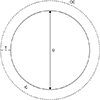1. Webb RC, Inscho EW. Age-related changes in the cardiovascular system. In : Aiyagari V, Gorelick PB, editors. Clinical Hypertension and Vascular Diseases: Hypertension in the Elderly. Totowa, NJ: Humana Press;2005. p. 11–21.
2. Karavidas A, Lazaros G, Tsiachris D, Pyrgakis V. Aging and the cardiovascular system. Hellenic J Cardiol. 2010; 51:421–427.
3. Fleg JL. Alterations in cardiovascular structure and function with advancing age. Am J Cardiol. 1986; 57:33C–44C.

4. Redheuil A, Yu WC, Mousseaux E, Harouni AA, Kachenoura N, Wu CO, Bluemke D, Lima JA. Age-related changes in aortic arch geometry: relationship with proximal aortic function and left ventricular mass and remodeling. J Am Coll Cardiol. 2011; 58:1262–1270.
5. Gerstenblith G, Frederiksen J, Yin FC, Fortuin NJ, Lakatta EG, Weisfeldt ML. Echocardiographic assessment of a normal adult aging population. Circulation. 1977; 56:273–278.

6. Xu X, Wang B, Ren C, Hu J, Greenberg DA, Chen T, Xie L, Jin K. Age-related impairment of vascular structure and functions. Aging Dis. 2017; 8:590–610.

7. Virmani R, Avolio AP, Mergner WJ, Robinowitz M, Herderick EE, Cornhill JF, Guo SY, Liu TH, Ou DY, O'Rourke M. Effect of aging on aortic morphology in populations with high and low prevalence of hypertension and atherosclerosis. Comparison between occidental and Chinese communities. Am J Pathol. 1991; 139:1119–1129.
8. Nagai Y, Metter EJ, Earley CJ, Kemper MK, Becker LC, Lakatta EG, Fleg JL. Increased carotid artery intimal-medial thickness in asymptomatic older subjects with exercise-induced myocardial ischemia. Circulation. 1998; 98:1504–1509.

9. Laurent S. Defining vascular aging and cardiovascular risk. J Hypertens. 2012; 30:Suppl. S3–S8.

10. Collins JA, Munoz JV, Patel TR, Loukas M, Tubbs RS. The anatomy of the aging aorta. Clin Anat. 2014; 27:463–466.

11. Cheuk BL, Cheng SW. Expression of integrin alpha5beta1 and the relationship to collagen and elastin content in human suprarenal and infrarenal aortas. Vasc Endovascular Surg. 2005; 39:245–251.
12. Aquaro GD, Cagnolo A, Tiwari KK, Todiere G, Bevilacqua S, Di Bella G, Ait-Ali L, Festa P, Glauber M, Lombardi M. Age-dependent changes in elastic properties of thoracic aorta evaluated by magnetic resonance in normal subjects. Interact Cardiovasc Thorac Surg. 2013; 17:674–679.

13. Moore KL, Dalley AF, Agur AM. Clinically oriented anatomy. 7th ed. Philadelphia, PA: Wolters Kluwer Health/Lippincott Williams & Wilkins;2013.
14. Drake R, Vogl AW, Mitchell AW. Gray's anatomy for students. 2nd ed. Philadelphia, PA: Elsevier Health Sciences;2009.
15. Gartner LP, Hiatt JL. Color atlas and text of histology. 6th ed. Philadelphia, PA: Lippincott Williams & Wilkins;2013.
16. Telser AG, Young JK, Baldwin KM. Elsevier's integrated histology. Philadelphia, PA: Elsevier;2007.
17. Maleszewski JJ, Lai CK, Veinot JP. Anatomic considerations and examination of cardiovascular specimens (excluding devices). In : Buja LM, Butany J, editors. Cardiovasc Pathology. London: Elsevier Science;2015. p. 23–25.
18. Greenwald SE. Ageing of the conduit arteries. J Pathol. 2007; 211:157–172.

19. da Silva ES, Rodrigues AJ Jr, Castro de Tolosa EM, Bueno Pereira PR, Zanoto A, Martins J. Variation of infrarenal aortic diameter: a necropsy study. J Vasc Surg. 1999; 29:920–927.

20. Sawabe M, Hamamatsu A, Chida K, Mieno MN, Ozawa T. Age is a major pathobiological determinant of aortic dilatation: a large autopsy study of community deaths. J Atheroscler Thromb. 2011; 18:157–165.

21. Fritze O, Romero B, Schleicher M, Jacob MP, Oh DY, Starcher B, Schenke-Layland K, Bujan J, Stock UA. Age-related changes in the elastic tissue of the human aorta. J Vasc Res. 2012; 49:77–86.

22. Movat HZ, More RH, Haust MD. The diffuse intimal thickening of the human aorta with aging. Am J Pathol. 1958; 34:1023–1031.
23. Schlatmann TJ, Becker AE. Histologic changes in the normal aging aorta: implications for dissecting aortic aneurysm. Am J Cardiol. 1977; 39:13–20.

24. Maurel E, Shuttleworth CA, Bouissou H. Interstitial collagens and ageing in human aorta. Virchows Arch A Pathol Anat Histopathol. 1987; 410:383–390.

25. Yamada H, Sakata N, Wada H, Tashiro T, Tayama E. Age-related distensibility and histology of the ascending aorta in elderly patients with acute aortic dissection. J Biomech. 2015; 48:3267–3273.

26. Alex RB, Amma LK. Microanatomical study of age changes in tunica media of ascending aorta. J Evol Med Dent Sci. 2016; 5:7409–7412.
27. Kumar V, Abbas AK, Aster JC. Robbins and Cotran pathologic basis of disease. 9th ed. Philadelphia, PA: Elsevier Health Sciences;2014.
28. Zarins CK, Glagov S. Artery wall pathology in atherosclerosis. In : Rutherford RB, editor. Vascular Surgery. Philadelphia, PA: WB Saunders;1989. p. 203–221.
29. Da Silva R. Anatomical study of the variation in the branching patterns and histology of the aorta in a South African population. Cape Town: University of Cape Town;2013.
30. Seki A, Fishbein MC. Cardiovascular pathology. 4th ed. Philadelphia, PA: Elsevier Science;2015.
31. Stary HC. Natural history and histological classification of atherosclerotic lesions: an update. Arterioscler Thromb Vasc Biol. 2000; 20:1177–1178.
32. Stary HC, Chandler AB, Dinsmore RE, Fuster V, Glagov S, Insull W Jr, Rosenfeld ME, Schwartz CJ, Wagner WD, Wissler RW. A definition of advanced types of atherosclerotic lesions and a histological classification of atherosclerosis. A report from the Committee on Vascular Lesions of the Council on Arteriosclerosis, American Heart Association. Circulation. 1995; 92:1355–1374.




 PDF
PDF ePub
ePub Citation
Citation Print
Print



 XML Download
XML Download